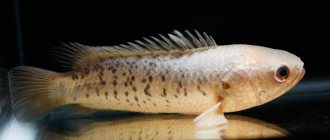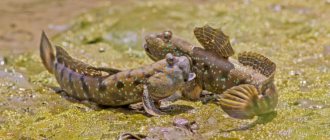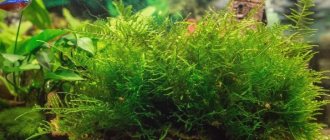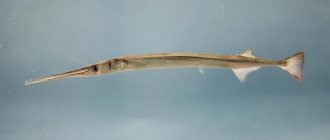by fisher November 14, 2017 0 Comments
Family: Polycentric
other fish
The leaf fish (Monocirrhus polyacanthus, Heckel, 1840) is one of two species of fish of the Polycentridae family, the unique body structure of which had a significant impact on its hunting tactics. The name of the genus to which the leaf fish comes from the Greek word monos - one and the Latin word cirrus - curl. In turn, the species name is derived from two Greek words, poly - many and acanthus - thorn.
In nature, the leaf fish inhabits water bodies related to the Amazon basin. Its habitat is quite wide and covers such rivers as the Rio Negro, Cusso and Essequibo in British Guiana.
During river floods and the subsequent decline of high water, monocirrhus remain in large numbers in the resulting forest oxbows, lakes and even puddles, the bottom of which is covered with a thick layer of fallen leaves. Despite its prevalence in nature, the wild leaffish is noticeably smaller than other species found in the same geographic areas.
The leaf fish is not large; it can confidently be classified as a small species. The length of its body, even in nature, usually does not exceed ten centimeters. The striking structural features of the fish include the absence of a lateral line, a large mouth extending far forward and a stalk-like process on the lower jaw, reminiscent of a leaf stalk. Thanks to its resemblance to a fallen leaf, which is enhanced by its always compressed fins, the leaf fish got its common name.
The leaf fish is not large, it can confidently be classified as a small species
The leaf fish has phenomenal adaptability, it has a strongly laterally compressed body, short fins with a large number of spiny rays and a characteristic olive-brown, camouflage color with dark streaks, varying depending on the environment from light gray to dark brown. This makes it practically invisible to both potential prey and visually oriented predators. Often people who have no idea what leaf fish do not immediately notice it in the aquarium.
Not only its appearance, but also behavior that matches its color helps the leaf fish to escape from predators
A stalk-like process on the lower jaw resembling a leaf stalk
At the slightest danger, it does not flee to the depths as other fish do, but with its fins spread out, it slowly descends, circling like a sinking leaf, and often does this by turning over on its side. Having reached the bottom, the leaf fish freezes, merging with the sunken foliage lying on the bottom. She remains in this position until the danger passes. In an aquarium, neither loud sounds nor movement behind the glass can bring her out of this state.
By its nature the leaf fish is an ambush predator; it hangs in the water column upside down, smoothly approaching potential prey. Seeing a fallen leaf floating downstream, the victim usually does not show concern. The predator continues to approach, slowly moving its transparent fins. Once at a sufficient distance for an attack, the leaf fish quickly throws its huge mouth towards the victim and sucks it in along with the water. The last action happens so quickly that it is impossible to catch it with your eyes.
She has a large mouth that extends far forward
Peculiarities
The leaf fish reaches a length of up to 8 cm. It has a high ovoid body, significantly flattened on the sides, a sharp snout with a small antennae on the chin. The color is variable and depends on the environment: yellow-green, with a marbled pattern, when the fish is hiding between plants, and brown (dark brown), with a marbled pattern, in open water. Thin dark stripes begin from the eye of the fish: one goes obliquely to “D” and up, the second to the root of “C”, the last one goes obliquely to the abdomen and down. The body and color of the fish resembles a dried leaf.
Lifestyle
Due to the almost complete absence of formed elements (erythrocytes) and hemoglobin in the blood, ice fish can withstand both great depths (up to 800 meters) and the harsh ice of Antarctica. Cold-resistant sea inhabitants are not used to migrating due to their limited distribution area.
This type of fish has a predatory lifestyle. They feed mainly on bottom inhabitants. Small crustaceans, shrimp, squid and some fish become easy money for them. Juveniles feed on a variety of plankton.
This is interesting! This type of fish has a distinctive feature in the respiratory process, which determines the difference in comparison with other species: they breathe mainly over the entire surface of the body, including through the fins, while the gills play a minor role.
Yandex pictures
Habits
The leaf fish is a predator and feeds only on small fish. Being unimportant swimmers use mimicry, being invisible, hanging motionless upside down in calm water, suddenly attacking unsuspecting prey. One gets the impression that the feeling of hunger never leaves this fish, with such “pike” greed it pounces on food, and how its huge eyes flare up and fade away as the victim approaches or moves away.
She can remain in this state for hours, not paying attention to anyone except the object of interest to her. The disproportionately huge mouth (60% of the size of the head) allows it to suck in a large amount of water along with the fish.
Difference from ice
When buying fish, it is sometimes difficult to distinguish one type of meat from another on the counter. It is more difficult when the fish is deliberately cleaned, the head, tail, and fins are removed, but not to make the task easier for the owner, but to sell the product at a higher price. When you see a fish called icefish among the carcasses, you need to take into account that there is a deception here. This is not one of the cheaper species of the white-blooded fish family, as buyers sometimes believe. Yes, the appearance, the presence of a small number of bones and the taste can occasionally resemble ice fish. But the ice fish itself does not exist in nature, and resourceful sellers instead sell other goods at a lower markup, explaining this as a type of ice fish. And buyers may well confuse white pike and pike caught in their homeland, in the rivers of the Murmansk region.
Yandex pictures
Leaf fish - keeping in an aquarium
Aquarists have known these strange fish for a relatively long time, but they have not gained much popularity. leaf fish are in amateur aquariums . There are several good reasons for this: firstly, their wide distribution is hampered by their not very peaceful disposition, secondly, they completely ignore any artificial feed and thirdly, they are very sensitive to changes in the basic hydrochemical parameters of water. In other words, this is not a fish for beginners. But thanks to its unique appearance and interesting behavior, it has fans among experienced aquarists.
To keep these amazing fish, an aquarium planted with large-leaved plants is recommended; echinodorus are best suited for this purpose. The lighting should be diffused, the soil should preferably be dark, and the presence of shelters in the form of dense thickets of aquatic flora, alternating with piles of stones, tree branches or snags, will create an environment favorable for fish.
Leaf fish in aquarium
It is a good idea to place several dry leaves of oak, beech or sea almond on the bottom of the aquarium, after soaking them, which will enhance the similarity of the aquarium interior with natural biotopes. The minimum capacity of the aquarium is 100 liters. This relatively small volume is enough to keep a small group of fish, consisting of 4-6 individuals.
Leaf fish prefer soft (up to 10dGH), slightly acidic (pH 6-6.8) water, with a temperature of 22-27°C. It can also be kept in moderately hard water with a neutral active reaction. It is better to stabilize the pH using peat filler in the filter. Fish are not demanding of aeration.
Based on the above, the best solution for keeping these fish is a species aquarium with effective water filtration, while water movement should be kept to a minimum.
The leaf fish is most active at dusk. The rest of the time she hangs motionless upside down among the plants.
Fish are aggressive both towards their fellows and towards representatives of other species. Juvenile leaf fish keep in schools; with age, this feature gradually disappears. Sexually mature individuals prefer solitude.
In a general aquarium, their neighbors can be some species of commensurate cichlids and medium-sized chain catfish.
The leaf fish sexual maturity at the age of one and a half years. Its lifespan in an aquarium is on average 8 years.
Diet
In nature, the basis of the diet of monocirrhus are various types of small fish, and their share in the diet is about 80%, the remaining 20% comes from invertebrates, mainly represented by insect larvae and crustaceans.
The leaf fish is capable of swallowing prey of a fairly impressive size, comparable to the size of the hunter himself.
In an aquarium, these fish should be fed exclusively with live food, with a predominance of fry of other fish. Moreover, it is enough to do this twice a week.
In the absence of small fish in the diet, monocirrhus quickly weaken and die. If it is not possible to provide such a menu, then you should abandon the content of this type.
Reproduction
For breeding, a spawning aquarium with a volume of 80 liters or more is required, the filling is similar to a regular aquarium for keeping. Water parameters: 26-28 °C, dH 2-4° (parameters recommended by I. Petrovitsky - dH up to 10°, but KH 0°), pH 6-6.5. O. Rybakov and A. Polonsky recommended soft lighting. For spawning, only one pair of fish is placed in the aquarium. The female can lay up to 300 eggs (the eggs are small, transparent) on a stone, driftwood or the underside of a large leaf, sometimes on the wall of the aquarium. Because The male takes care of the offspring of this species, washing the eggs with his fins; then, having received the clutch, the female is moved from the aquarium. The ripening of eggs takes 3-4 days; on the third day, when the fry begin to swim, the male is also relocated.
Fry should be fed small cyclops larvae and rotifers. Leaf fish reach sexual maturity at 16 months.
An aquarium for keeping such fish should be filled with plants, driftwood and pebbles.
M. Laifman and V. Raskov bred fish in a 100-liter aquarium, with Echinodorus plantings, stones and driftwood. The following water parameters were observed: 25-26 °C, dH 7 °, pH 6. Upon reaching 16 months, when the individuals were 8 cm in length, the female laid eggs on the reverse side of the leaf and was moved to another aquarium. The male was relocated when the fry swam. Observing them, V. Raskov and M. Laifman noted that they reacted voraciously to food of any size, but if very large specimens were found in the food, the fry died by choking. There were also cases of cannibalism among the fry.
S. Voronov, who also bred this species, noted that for successful breeding, the water he used required careful purification through a high-power filter made in the USA, after which it acquired a light bluish color. S. Voronov used large-leaved plastic plants as a substrate and specially bent the ends of the leaves down to stimulate spawning. He placed one female and two males in the aquarium, maintaining the water temperature at 28-29 °C.
The fish resemble floating dried leaves.
S. Voronov moved the laid eggs to another aquarium with conditions similar to the spawning one, with the exception of water: a solution of methylene blue in a weak concentration was added to it. The movement was caused by the death of eggs in the spawning ground: the eggs were torn off from the substrate due to the flapping of the male's fins. Its function in the aquarium was performed by a filter with water intake slots covered with foam rubber to protect the larvae from getting inside.
From the notes of S. Voronov: “You need to start feeding with rotifers. Give for the first seven days, then switch to a small cyclops. When the fry grow to 2.5 cm, you can feed them with juvenile fish of other species. I did not observe cannibalism among the fry: I kept fry of different ages together (4-5 mm and 10-12 mm long). You can use koretra as feed for the shoots, but be careful not to choke. A combination of juveniles of other fish species and Cyclops is best suited; Bloodworms and tubifex, as food, do not cause reactions in young animals. At the end of feeding, it is necessary to refresh the water: an acidic environment leads to the death of the fry, so one-sixth of the volume of the aquarium should be replaced, observing the water parameters.”
Leaffish suffer from swollen eyes, so you need to monitor the temperature of the water in the aquarium.
He also made an important discovery for keeping fish: “The eyes of leaf fish are susceptible to a common disease - swelling. I discovered the treatment by accident: I increased the water temperature to 32-34 °C and significantly aerated it. With these parameters, the eyes return to normal and recovery is observed.
Habitat
Comes from South America from the territory of modern Brazil, Peru, Venezuela, Colombia and Bolivia.
It lives in numerous river systems among tropical forests. Prefers shallow water regions with slow currents and numerous snags and fallen leaves. Brief information:
- Aquarium volume - from 70 liters.
- Temperature - 23–29°C
- pH value – 5.0–6.8
- Water hardness - soft (1–10 dGH)
- Substrate type - any dark
- Lighting - dim
- Brackish water - no
- Water movement is very weak
- The size of the fish is up to 10 cm.
- Food: live fish
- Temperament - quarrelsome
- Keeping alone or in a male/female pair
Fish diseases
The main cause of most diseases is unsuitable living conditions and poor quality food. If the first symptoms are detected, you should check the water parameters and the presence of high concentrations of hazardous substances (ammonia, nitrites, nitrates, etc.), if necessary, bring the indicators back to normal, and only then begin treatment.
MUD JUMPER: DESCRIPTION, CARE AND MAINTENANCE IN THE AQUARIUM, PHOTO
SPRAY FISH: DESCRIPTION, CONTENTS, BREEDING, PHOTO, VIDEO
BARBUS CRUSADE: CONTENTS, BREEDING, PHOTO, DESCRIPTION.
Benefits and harms
Ice fish has many beneficial properties. It contains:
- Vitamins: B1, B2, PP, B6, B9;
- Microelements: chromium, magnesium, fluorine, cobalt, sodium, phosphorus, iodine, potassium, sulfur.
Due to the fact that this fish lives in the cold conditions of ecologically clean regions, its meat is doubly valuable: it does not accumulate toxins and is safe to consume. Meat is recommended in the case of a dietary plan for people with cardiovascular diseases and thyroid disorders.
The only possible contraindication for use is for children under 1 year of age.
Yandex pictures
For children
Children don't always like fish dishes. But you can interest them with an unusual presentation, for example, feed them an airy fish soufflé.
- Number of servings: 2.
- Total cooking time: 40 min.
- Time to prepare food: 10 min.
- Energy value per 100 grams of dish: 137 kcal.
- Used: 12.2/9/1.5.
Ingredients:
- Fish - 200 gr.
- Chicken egg - 2 pcs.
- Milk - 100 ml.
- Butter - 1/2 tsp.
- Vegetable oil - 1 tbsp. l.
- Salt - to taste.
- Clean the fish, separate the tail, head, fins and bones with entrails.
- If desired, separate the skin.
- Cut the resulting fillet into small pieces.
- Place the pieces in a blender.
- After breaking the eggs, separate the yolks and add to the blender.
- Pour in the butter, milk and salt.
- Beat the mixture thoroughly in a blender until smooth.
- Next, prepare silicone molds (ceramic can be used), grease them with oil and pour the homogeneous contents into them.
Important! It is necessary to leave about 1 cm from the very edges of the mold, as the soufflé will rise.
- Set up a water bath and steam the dish for 35 minutes. You can also bake the soufflé in the oven for half an hour at 170 degrees without any hassle.
- After waiting the required time, carefully take each ramekin and turn it over so that the contents release onto a plate.
- The finished fish soufflé not only looks beautiful on the table, but also has a number of advantages in the form of beneficial properties for the body, which is necessary for children.
Yandex pictures
In a frying pan
Fish breaded with paprika and lemon zest
- Cooking time: 30 min.
- Number of servings: 4.
- K/B/F/U: 140/15.2/4.4/10.
Ingredients:
- Ice fish – 12 pcs.
- Wheat flour - 200 gr.
- Lemon - 4 pcs.
- Vegetable oil - 4 tbsp. l.
- Paprika - 2-3 tbsp. l.
- Black pepper - to taste
- Salt - 1-2 tsp.
Recipe step by step:
- Thaw the fish in advance, remove the entrails from the carcasses, and rinse
- Mix salt, pepper, paprika with flour.
- Next, grate the zest of each lemon.
- Coat each carcass with zest, pour a little inside the belly.
- Sprinkle the prepared mixture of flour and spices on the board and roll the fish in it.
- Pour oil into a heated frying pan, after a minute lower the fish one by one. When one side begins to brown (after about 3-4 minutes), turn it over to the other and fry the same amount.
- Whenever possible, remove any burnt flour from the bottom of the pan during cooking.
- Serve the fried white blood, after sprinkling it with lemon juice.
Yandex pictures
Cutlets
Chopped fish cutlets are good even when cooled. This is a definite plus when preparing a side dish immediately after the main dish. French fries, rice with vegetables and mashed potatoes go well with cutlets.
- Designed for 4 persons.
- Preparation time: 15 min.
- Cooking time: 40 min.
Calorie content: 126.3 kcal.
Proteins – 14
Fats – 5
Carbohydrates – 7. Ingredients for the recipe:
- Fish fillet - 2 pcs.
- Chicken egg - 1 pc.
- Onions - 1/2 pcs.
- Starch - 2 tbsp. l.
- Mayonnaise - 1 tbsp. l. (with a slide)
- Dill - 2 pcs.
- Salt, pepper - to taste
Recipe for hearty fish cutlets:
- Separate the tail, ridge, and head from the defrosted fish. The separated parts can be set aside for thick fish soup.
- Finely chop the fillet.
- Chop the onion and send to the fish.
- Beat the egg into the same container, pepper, add mayonnaise, starch, and mix everything.
Tip: you can use flour instead of starch, but then the dish will come out dry and tough. But instead of mayonnaise, if something happens, you can safely use sour cream or thick cream.
- Chop the dill into a bowl with the fish, add salt and mix again.
- Then you can leave it to soak for half an hour in the refrigerator. But the taste will not deteriorate even if you fry the cutlets right away.
- Heat the frying pan thoroughly, add oil and spoon in the minced fish, forming oval shapes in place.
- After the crusts appear, turn over, fry the other side and simmer under the lid over low heat for another 5-7 minutes.
- Place the finished cutlets on a paper towel to absorb excess oil.
Yandex pictures











